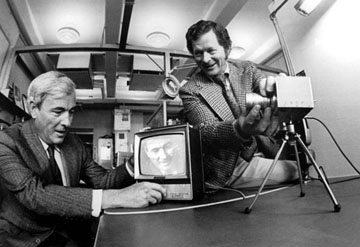Willard Sterling Boyle, CC, physicist (born 19 August 1924 in Amherst, NS; died 7 May 2011 in Truro, NS). Willard S. Boyle is best known for his contribution towards the charge-coupled device (CCD), which he is credited for co-inventing with George E. Smith. The CCD is the basis for multiple types of imaging and an essential part of digital cameras, bar code readers, satellite surveillance technology and the Hubble space telescope. (See also Technology in Canada.) In 2009, Boyle and Smith were jointly awarded half the Nobel Prize in Physics for their invention of the CCD (see Nobel Prizes and Canada).

Early Life and Education
Willard Boyle grew up in northern Quebec, his family having moved there from Nova Scotia when he was a small child. His father was a physician in the logging community of Chaudière. Boyle’s mother home schooled him until he began his formal education at Lower Canada College when he was 14. Boyle went on to study at McGill University, but in 1943 enlisted in the Royal Canadian Navy and served in the Fleet Air Arm as a Spitfire pilot. After the Second World War he resumed his education, earning bachelor (1947) and master (1948) of science degrees and a doctorate (1950) in physics at McGill University.
Career
After completing his doctorate, Willard Boyle worked at McGill University's radiation laboratory for a year before taking a position teaching physics at the Royal Military College of Canada in Kingston. In 1953, he joined the research staff at Bell Labs in Murray Hill, New Jersey. During his career with Bell Labs, he worked on approximately 18 patents. Boyle was also part of several discoveries at Bell Labs, including the first continuously operating ruby laser with colleague Don Nelson in 1962 (see Laser).
Also in 1962, Boyle became the Director of Space Science and Exploratory Studies at Bellcomm, a division of Bell Labs. In that position, he provided support for the Apollo space program and helped select lunar landing sites.
Boyle returned to Bell Labs in 1964 and in 1969, with George Smith, created the CCD. Boyle retired from Bell Labs in 1979 as the Executive Director of the Communication Science division. During his retirement, he provided leadership to the Research Council of the Canadian Institute of Advanced Research, and to the Nova Scotia Council for Applied Science and Technology.
Invention of the Charge-Coupled Device (CCD)
Willard Boyle and George Smith credited vigorous brainstorming sessions for inspiring their invention of the now ubiquitous CCD. Smaller than a dime, the device takes advantage of the photoelectric effect, the explanation of which earned Albert Einstein the Nobel prize in 1921. The photoelectric effect observes that light shined onto a piece of metal causes a small current to flow through the metal. The CCD captures light, stores it, and then displays it by converting it into electrical charges. It allowed images to be captured electronically, instead of on film.
2009 Nobel Prize in Physics
Willard Boyle and George Smith were jointly awarded half the 2009 Nobel Prize in Physics "for the invention of the imaging semiconductor circuit - the CCD sensor." The other half of the prize was given to Charles Kuen Kao for his research on fibre-optic cables. (See also Nobel Prizes and Canada.)
After Boyle and Smith were awarded the Nobel prize, other Bell scientists claimed credit for the CCD discovery, saying that the original purpose of the device did not concern imaging but memory. However, Boyle and Smith filed their patent four years ahead of the other scientists and had documentation disproving the detracting claims.
Select Honours and Awards
- Ballantyne Medal, Franklin Institute (1973)
- Morris Liebmann Award, Institute of Electrical and Electronics Engineers (1974)
- Co-Winner, C&C Prize, NEC Foundation (1999)
- Inductee, Canadian Science and Engineering Hall of Fame (2005)
- Charles Stark Draper Prize, National Academy of Engineering (2006)
- Nobel Prize in Physics, Royal Swedish Academy of Sciences (2009)
- Companion, Order of Canada (2010)

 Share on Facebook
Share on Facebook Share on X
Share on X Share by Email
Share by Email Share on Google Classroom
Share on Google Classroom











